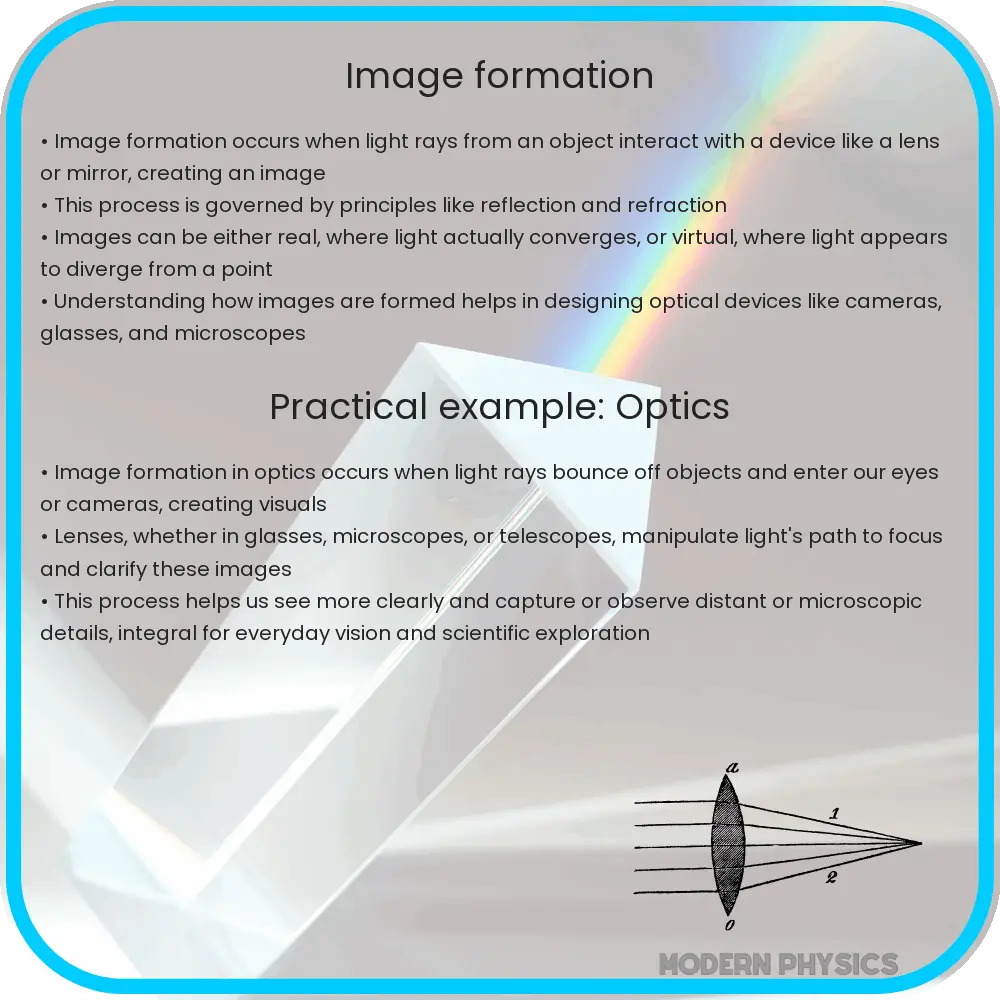Explore the essentials of geometrical optics, covering image formation principles, advanced techniques, and their diverse applications in technology.

Understanding Image Formation in Geometrical Optics
The world of geometrical optics is fascinating, encompassing principles and techniques that are essential for understanding how images are formed. This article delves into the core concepts of image formation in geometrical optics, exploring its principles, techniques, and diverse applications.
Principles of Image Formation
At the heart of geometrical optics lies the principle of light propagation. Light travels in straight lines through a homogeneous medium. When it encounters a boundary between two different media, phenomena such as reflection and refraction occur, which are pivotal in image formation.
Reflection is based on the law of reflection, stating that the angle of incidence (θi) is equal to the angle of reflection (θr). This principle is fundamental in the operation of mirrors, whether they are flat, concave, or convex.
Refraction, on the other hand, involves the bending of light as it passes from one medium to another with a different refractive index. Snell’s Law, defined as n1sin(θ1) = n2sin(θ2), where n represents the refractive indices and θ the angles of incidence and refraction, governs this process. Refraction is crucial in lenses, contributing to their ability to converge or diverge light rays.
Techniques in Geometrical Optics
Geometrical optics employs several techniques for image formation. The most prominent among these is the use of lenses and mirrors. Lenses, either convex or concave, manipulate the path of light rays to form images. The nature of the image – whether real or virtual, upright or inverted – depends on factors like the lens type, object distance, and focal length.
Mirrors also play a significant role in image formation. They are typically categorized into plane, concave, and convex mirrors, each having unique image-forming characteristics. For instance, plane mirrors create virtual images that are laterally inverted, while concave mirrors can produce both real and virtual images based on the object’s position relative to the mirror’s focal point.
Applications in Various Fields
The applications of geometrical optics are vast and diverse, influencing various fields. In medical technology, optics is crucial in devices like endoscopes and microscopes. In astronomy, telescopes employ principles of reflection and refraction to observe distant celestial objects. Similarly, in photography, camera lenses utilize optical principles to capture images. These applications demonstrate the broad impact and significance of geometrical optics in both scientific and everyday contexts.
Understanding the principles and techniques of image formation in geometrical optics not only enhances our knowledge of physics but also offers insights into the workings of various optical devices that are integral to numerous technological advancements.
Advanced Concepts in Image Formation
Beyond basic principles, geometrical optics encompasses advanced concepts that further our understanding of image formation. One such concept is the optical path length (OPL), which considers the distance light travels in different media, adjusted for the media’s refractive index. This concept is crucial in understanding phenomena like interference and diffraction.
Another advanced concept is the thin lens equation, given by 1/f = 1/do + 1/di, where f is the focal length, do the object distance, and di the image distance. This equation is vital in lens design and analysis, allowing for precise calculations of image placement and characteristics.
Technological Advancements and Future Trends
The field of geometrical optics is not static but continuously evolving with technological advancements. One of the most exciting areas of development is in the realm of adaptive optics. This technology, primarily used in astronomical telescopes, compensates for atmospheric distortion, resulting in clearer and more detailed images of celestial objects.
Another burgeoning area is the use of metamaterials in optics. These artificially engineered materials have unique properties not found in nature, allowing for novel ways of manipulating light. This opens up possibilities for creating super lenses that surpass the diffraction limit of conventional lenses, potentially revolutionizing fields like microscopy and nanotechnology.
Conclusion
The study of image formation in geometrical optics is a blend of fundamental principles, advanced concepts, and cutting-edge technological applications. From the basic laws of reflection and refraction to the intricate design of modern optical devices, this field continues to be a cornerstone of scientific exploration and technological innovation.
As we advance further into the 21st century, the applications of geometrical optics are bound to expand, influencing sectors like telecommunications, health care, and environmental science. This ongoing evolution underscores the importance of a deep understanding of optical principles, not only for physicists and engineers but for anyone keen on comprehending the technological marvels of our time.
In conclusion, geometrical optics offers a fascinating window into the behavior of light and its interaction with matter, providing a foundation for countless innovations that shape our world. As we continue to push the boundaries of what is possible with light, the principles of geometrical optics will remain a guiding light, illuminating the path to new discoveries and advancements.
Is this conversation helpful so far?
